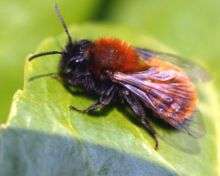Tawny mining bee
| Andrena fulva | |
|---|---|
 | |
| Scientific classification | |
| Kingdom: | Animalia |
| Phylum: | Arthropoda |
| Class: | Insecta |
| Order: | Hymenoptera |
| Family: | Andrenidae |
| Subfamily: | Andreninae |
| Genus: | Andrena |
| Species: | A. fulva |
| Binomial name | |
| Andrena fulva Müller, 1766 | |
The tawny mining bee, Andrena fulva, is a European species of the sand bee (Andrena) genus. The males are 10–12 mm (0.4–0.5 in) and the females 8–10 mm (0.3–0.4 in) long. It is covered with hair: fox-red on its back and black on its underside.
The tawny mining bee lives in Europe, ranging from the Balkans to southern Scandinavia and the United Kingdom. It lives in light woodlands and dry grasslands, and also in parks and gardens. It is widely distributed but has a low population density. The Tawny mining bee flies from March until May. It prefers to fly in a multitude to different nectar-bearing plants. It lives in a nest in the ground, and occasionally in larger colonies.
It mates in spring, after which the male dies and the female starts to build a nest. Sometimes more than a hundred females build nests in a few square metres but the tawny mining bee normally does not create a colony: each female has her own nest. The tawny mining bee is therefore classified amongst solitary and communal bees.
The nest is a vertical shaft 200–300 mm (8–12 in), with several brood cells branching off it. The female fills these cells with a mixture of nectar and pollen, on which she lays one egg in each cell. The larva hatches within a few days, grows quickly and pupates within a few weeks. The adults emerge in spring after hibernation.